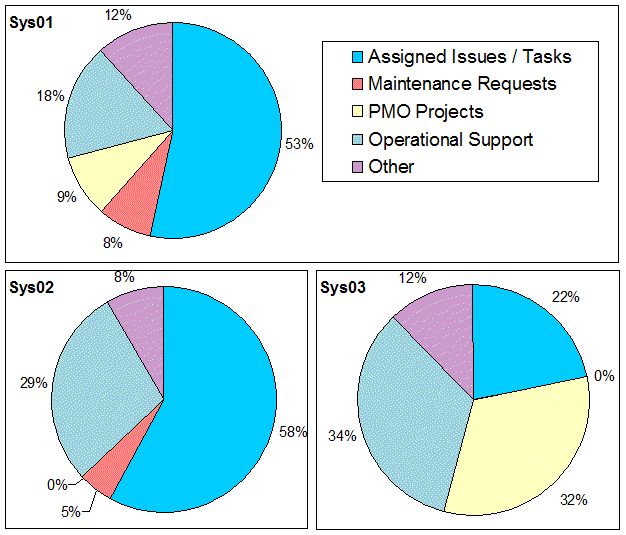In the early part of the year, we tracked our time as a group using timesheets. We don’t use these to justify our payroll or anything, just an exercise to validate that we were properly apportioning our time across multiple demands. Also, we wanted to help explain why it takes more than one week of calendar time to complete one week of effort time.
As I was scanning old emails, I came across the summary / findings note that I had written, and thought it might be of some interest here.
Observable yet Relatively Painless
To get a higher level of participation / compliance, we kept the detail at a reasonable level. There was no space for status updates, summary notes, anything like that – we just wanted to create a quick “hash total” of time spent in key areas. Also, we only tracked actual work time, and ignored vacations / holidays, breaks, lunch, etc. A single Excel file contained a collection of timesheets – one per person, on it’s own tab in the workbook. Each Excel file has the timesheets for the week – the file name has the date of the Monday that begins the week. The expectation was that folks filled out their timesheet data by 10a on the first business day of each week – so I could generate metrics.
The time sheets are designed to facilitate a simple, manual process; a week’s sheet always fits on two sheets, so if you print in 2-sided mode, you’ll only have a single sheet of paper to walk around with. Time is tracked in a limited number of categories; the terms in the sample sheet refer to our internal PMO tools, nothing stunning or proprietary there. The major categories are:
- Assigned Issues/Tasks: Assigned via our issue tracking system.
- Maintenance Requests: Larger chunks of work, not big enough to be projects in their own right
- PMO Projects: All work done for named projects that are tracked in our Project Management Office
- Operational / Support Tasks: Covers normal tasks involved in day to day operation of the system(s); ex. backup operations, doing a billing, generating delivery tickets, running financial or operational reports, maintaining customer information, control / master files, etc.
- Other: For time spent on other stuff that does not fall easily into one of the above categories
We only tracked time in 30 minute chunks; if more that one thing was worked on in a 30 minute period, we just picked the category that best represented the major portion of that time span. Remember, we’re trying to stay away from too much detail. Also, the spreadsheet was fairly smart, in that all you had to do was put an x in the grid and all the math was automatic. It also checked for multiple x’s in the same column – see the problems highlighted from 3-4 in the sample below …

Results were Mixed
We split our tracking across three major systems platforms – we’ll call them Sys01, Sys02, and Sys03 – and took a look at how the different areas compared. In fact, we stopped the time tracking process based on inherent problems in the “oversimplification” of the metrics. For example – check out the aggregate stats below …

“Maintenance Requests” are in red – and it looks like we’re not paying so much attention to that in any platform. Problem is, the platform that historically has relied on the prioritization of “maint requests” (Sys01) is moving towards using the issue tracking system to prioritize all work. Also – Sys02 group is doing more work in the issue tracking system that is more request and Support in nature, and some of that work might be classified as Operational Support – but since it’s got a Issue number assigned, it gets mixed in with other stuff. Bottom line: our issue tracking system can handle operations support, issues, and requests – so there is a bit more subtlety than can be expressed easily with the current timesheet format.
One key thing to note – very little New Project work was getting done, and the only reason the Sys03 platform is so project driven is because the hours are skewed by two specific current projects that monopolized that group’s time.
We did halt the time tracking process, but some folks have continued using them, just to put more observability into there daily routine.





Comments (0)